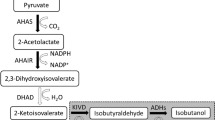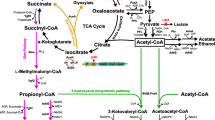Abstract
Methyl ketones are a group of highly reduced platform chemicals with widespread applications in the fragrance, flavor and pharmacological industries. Current methods for the industrial production of methyl ketones include oxidation of hydrocarbons, but recent advances in the characterization of methyl ketone synthases from wild tomato have sparked interest towards the development of microbial platforms for the industrial production of methyl ketones. A functional methyl ketone biosynthetic pathway was constructed in Escherichia coli by over-expressing two genes from Solanum habrochaites: shmks2, encoding a 3-ketoacyl-ACP thioesterase, and shmks1, encoding a beta-decarboxylase. These enzymes enabled methyl ketone synthesis from 3-ketoacyl-ACP, an intermediate in the fatty acid biosynthetic cycle. The production of 2-nonanone, 2-undecanone, and 2-tridecanone by MG1655 pTH-shmks2-shmks1 was initially detected by nuclear magnetic resonance and gas chromatography–mass spectrometry analyses at levels close to 6 mg/L. The deletion of major fermentative pathways leading to ethanol (adhE), lactate (ldhA), and acetate (pta, poxB) production allowed for the carbon flux to be redirected towards methyl ketone production, doubling total methyl ketone concentration. Variations in methyl ketone production observed under different working volumes in flask experiments led to a more detailed analysis of the effects of oxygen availability on methyl ketone concentration in order to determine optimal levels of oxygen. The methyl ketone concentration achieved with MG1655 ∆adhE ∆ldhA ∆poxB ∆pta pTrcHis2A-shmks2-shmks1, the best performer strain in this study, was approximately 500 mg/L, the highest reported for an engineered microorganism. Through the establishment of optimal operating conditions and by executing rational metabolic engineering strategies, we were able to increase methyl ketone concentrations by almost 75-fold from the initial confirmatory levels.








Similar content being viewed by others
References
Baltazar MF, Dickinson FM, Ratledge C (1999) Oxidation of medium-chain acyl-CoA esters by extracts of Aspergillus niger: enzymology and characterization of intermediates by HPLC. Microbiology 145:271–278
Ben-Israel I, Yu G, Austin MB, Bhuiyan N, Auldridge M, Nguyen T, Schauvinhold I, Noel JP, Pichersky E, Fridman E (2009) Multiple biochemical and morphological factors underlie the production of methylketones in tomato trichomes. Plant Physiol 151(4):1952–1964. doi:10.1104/pp.109.146415
Bernardi R, Cardani C, Ghiringh.D, Selva A, Baggini A, Pavan M (1967) On components of secretion of mandibular glands on ant Lasius (Dendrolasius) fuliginosus. Tetrahedron Lett (40):3893
Bianchi F, Careri M, Mangia A, Mattarozzi M, Musci M, Concina I, Falasconi M, Gobbi E, Pardo M, Sberveglieri G (2009) Differentiation of the volatile profile of microbiologically contaminated canned tomatoes by dynamic headspace extraction followed by gas chromatography-mass spectrometry analysis. Talanta 77(3):962–970. doi:10.1016/j.talanta.2008.07.061
Bolster MG, Jansen BJM, de Groot A (2001) The synthesis of Ambrox((R))-like compounds starting from (+)−larixol. Tetrahedron 57(26):5663–5679. doi:10.1016/s0040-4020(01)00494-x
Cavill GWK, Ford DL, Locksley HD (1956) The chemistry of ants I. Terpenoid constituents of some Australian Iridomyrmex species. Aust J Chem 9(2):288–293
Cavill GWK, Hinterberger H (1960) The chemistry of ants IV. Terpenoid constituents of some Dolichoderus and Iridomyrmex species. Aust J Chem 13(4):514–519
Clark DP (1989) The fermentation pathways of Escherichia coli. FEMS Microbiol Rev 63(3):223–234. doi:10.1016/0168-6445(89)90033-8
Datsenko KA, Wanner BL (2000) One-step inactivation of chromosomal genes in Escherichia coli K-12 using PCR products. Proc Natl Acad Sci USA 97(12):6640–6645
Dharmadi Y, Gonzalez R (2005) A better global resolution function and a novel iterative stochastic search method for optimization of high-performance liquid chromatographic separation. J Chromatogr A 1070(1–2):89–101. doi:10.1016/j.chroma.2005.02.075
Dharmadi Y, Murarka A, Gonzalez R (2006) Anaerobic fermentation of glycerol by Escherichia coli: a new platform for metabolic engineering. Biotechnol Bioeng 94(5):821–829. doi:10.1002/bit.21025
Durnin G, Clomburg J, Yeates Z, Alvarez PJJ, Zygourakis K, Campbell P, Gonzalez R (2009) Understanding and harnessing the microaerobic metabolism of glycerol in Escherichia coli. Biotechnol Bioeng 103(1):148–161. doi:10.1002/bit.22246
Forney FW, Markovetz AJ (1971) The biology of methyl ketones. J Lipid Res 12:383–395
Fridman E, Wang JH, Iijima Y, Froehlich JE, Gang DR, Ohlrogge J, Pichersky E (2005) Metabolic, genomic, and biochemical analyses of glandular trichomes from the wild tomato species Lycopersicon hirsutum identify a key enzyme in the biosynthesis of methylketones. Plant Cell 17(4):1252–1267. doi:10.1105/tpc.104.029736
Gehrig RF, Knight SG (1958) Formation of ketones from fatty acids by spores of Penicillium roqueforti. Nature 182(4644):1237. doi:10.1038/1821237a0
Goh EB, Baidoo EEK, Keasling JD, Beller HR (2012) Engineering of bacterial methyl ketone synthesis for biofuels. Appl Environ Microbiol 78(1):70–80. doi:10.1128/aem.06785-11
Guichard E, Souty M (1988) Comparison of the relative quantities of aroma compounds found in fresh apricot (Prunus armeniaca) from 6 different varieties. Z Lebensm Unters Forsch 186(4):301–307. doi:10.1007/bf01027031
Guo Y, Wu X-L, Xu R-Q, Li J-L, Shi Z (2008) A novel method for biomimetic synthesis of methyl ketone perfume. Chin J Org Chem 28(12):2181–2185
Hayes WS, Borodovsky M (1998) Deriving ribosomal binding site (RBS) statistical models from unannotated DNA sequences and the use of the RBS model for N-terminal prediction. Pac Symp Biocomput 1998:279–290
Hou CT, Patel R, Laskin AI, Barnabe N, Barist I (1983) Production of methyl ketones from secondary alcohols by cell-suspensions of C-2 to C-4 n-alkane-grown bacteria. Appl Environ Microbiol 46(1):178–184
Kang YS, Durfee T, Glasner JD, Qiu Y, Frisch D, Winterberg KM, Blattner F (2004) Systematic mutagenesis of the Escherichia coli genome. J Bacteriol 186(15):4921–4930. doi:10.1128/jb.186.15.1921-1930.2004
Kang YS, Durfee T, Glasner JD, Qiu Y, Frisch D, Winterberg KM, Blattner FR (2004) Systematic mutagenesis of the Escherichia coli genome. J Bacteriol 186:4921–4930. doi:10.1128/jb.186.24.8548.2004
Leadbetter ER, Foster JW (1959) Oxidation products formed from gaseous alkanes by the bacterium Pseudomonas methanica. Arch Biochem Biophys 82(2):491–492. doi:10.1016/0003-9861(59)90154-7
Leadbetter ER, Foster JW (1960) Bacterial oxidation of gaseous alkanes. Arch Mikrobiol 35(1):92–104. doi:10.1007/bf00425597
Lewis HL, Darnall DW (1970) Fatty acid toxicity and methyl ketone production in Aspergillus niger. J Bacteriol 101(1):65
Lukins HB, Foster JW (1963) Methyl ketone metabolism in hydrocarbon-utilizing mycobacteria. J Bacteriol 85(5):1074
Miller J (1992) A short course on bacterial genetics: a laboratory manual and handbook for Escherichia coli and related bacteria. Cold Spring Harbor Laboratory Press, New York
Moser JC, Brownlee RC, Silverst R (1968) Alarm pheromones of ant Atta texana. J Insect Physiol 14(4):529. doi:10.1016/0022-1910(68)90068-1
Neidhardt FC, Bloch PL, Smith DF (1974) Culture medium for enterobacteria. J Bacteriol 119(3):736–747
Sambrook J, Russell D (2001) Molecular cloning: a laboratory manual, 3rd edn. Cold Spring Harbor Laboratory Press, New York
Shearer DA, Boch R (1965) 2-Heptanone in mandibular gland secretion of honey-bee. Nature 206(4983):530 doi:10.1038/206530a0
Shi AB, Nguyen TA, Battina SK, Rana S, Takemoto DJ, Chiang PK, Hua DH (2008) Synthesis and anti-breast cancer activities of substituted quinolines. Bioorg Med Chem Lett 18(11):3364–3368. doi:10.1016/j.bmcl.2008.04.024
Solis-Solis HM, Calderon-Santoyo M, Schorr-Galindo S, Luna-Solano G, Ragazzo-Sanchez JA (2007) Characterization of aroma potential of apricot varieties using different extraction techniques. Food Chem 105(2):829–837. doi:10.1016/j.foodchem.2007.01.061
Thaler H, Eisenlohr W (1941) The chemistry of ketone rancidity III. Announcement: on the formation of methyl-ketone made from alpha, beta-unsaturated fatty acids using Penicillium glaucum. Biochem Z 308(2):88–102
Tolosa L, Kostov Y, Harms P, Rao G (2002) Noninvasive measurement of dissolved oxygen in shake flasks. Biotechnol Bioeng 80(5):594–597. doi:10.1002/bit.10409
Watts F (1886) On the essential oil of lime leaves (Citrus limetta). J Chem Soc Trans 49:316–317
Wehmer C (1931) Die pflanzenstoffe: botanisch–systematisch bearbeitet, vol 1, 2nd edn. Gustav Fisher, Jena
Williams CG (1857) On the constitution of the essential oil of rue. Proc R Soc Lond 9:167–169
Yazdani SS, Gonzalez R (2008) Engineering Escherichia coli for the efficient conversion of glycerol to ethanol and co-products. Metab Eng 10(6):340–351. doi:10.1016/j.ymben.2008.08.005
Yu G, Nguyen TTH, Guo Y, Schauvinhold I, Auldridge ME, Bhuiyan N, Ben-Israel I, Iijima Y, Fridman E, Noel JP, Pichersky E (2010) Enzymatic functions of wild tomato methylketone synthases 1 and 2. Plant Physiol 154(1):67–77. doi:10.1104/pp.110.157073
Zhang XJ, Li M, Agrawal A, San KY (2011) Efficient free fatty acid production in Escherichia coli using plant acyl-ACP thioesterases. Metab Eng 13(6):713–722. doi:10.1016/j.ymben.2011.09.007
Zhu D, Ling H (2009) Synthetic applications of ketoreductases and alcohol oxidases. In: Tao J, Lin G-Q, Liese A (eds) Biocatalysis for the pharmaceutical industry: discovery, development, and manufacturing. John Wiley & Sons, Chichester, chapter 7, pp 121–151. doi:10.1002/9780470823163.ch7
Acknowledgments
This work was supported by the US National Science Foundation (EEC-0813570).
Author information
Authors and Affiliations
Corresponding author
Additional information
John Park and María Rodríguez-Moyá contributed equally to this work.
Rights and permissions
About this article
Cite this article
Park, J., Rodríguez-Moyá, M., Li, M. et al. Synthesis of methyl ketones by metabolically engineered Escherichia coli . J Ind Microbiol Biotechnol 39, 1703–1712 (2012). https://doi.org/10.1007/s10295-012-1178-x
Received:
Accepted:
Published:
Issue Date:
DOI: https://doi.org/10.1007/s10295-012-1178-x




